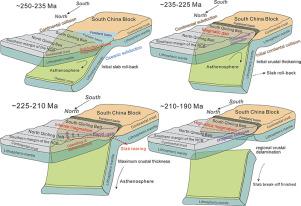当前位置:
X-MOL 学术
›
Gondwana Res.
›
论文详情
Our official English website, www.x-mol.net, welcomes your
feedback! (Note: you will need to create a separate account there.)
Early Mesozoic magmatism and tectonic evolution of the Qinling Orogen: Implications for oblique continental collision
Gondwana Research ( IF 7.2 ) Pub Date : 2020-12-01 , DOI: 10.1016/j.gr.2020.07.006 Fangyang Hu , Shuwen Liu , Mihai N. Ducea , James B. Chapman , Fuyuan Wu , Timothy Kusky
Gondwana Research ( IF 7.2 ) Pub Date : 2020-12-01 , DOI: 10.1016/j.gr.2020.07.006 Fangyang Hu , Shuwen Liu , Mihai N. Ducea , James B. Chapman , Fuyuan Wu , Timothy Kusky

|
Abstract The Qinling Orogenic Belt in Central China is formed by an oblique continental collision between the North China and South China Blocks. In this review, we summarize the knowledge of the early Mesozoic magmatism, in combination with the coeval metamorphic characteristics, regional structural features and depositional history in the foreland and hinterland basins along the Qinling-Dabie Orogen. The early Mesozoic tectonic evolution of the Qinling is divided into four stages. Stage I (~250–235 Ma) is characterized by medium-K calc-alkaline magmatism in the western Qinling induced by slab roll-back. Meanwhile, ultrahigh-pressure metamorphism was triggered by continental subduction in the Sulu-Dabie, indicating a diachronous closure of the ocean. Stage II (~235–225 Ma) is recognized as a magmatic gap. Depositional variations of sedimentary facies and compressional deformations with an increased crustal thickness reflect the initial collision in the Qinling. Stage III (~225–210 Ma) is distinguished by a magmatic flare-up event. Abundant mantle-derived melts coupled with extensive crustal-derived melts were coeval with rapid uplift, strike-slip movement and regional crustal thickening in the Qinling as well as retrograde metamorphism in the Sulu-Dabie. The main tectonic driver was the propagating detachment of the subducted oceanic slab at gradually shallower depth from the Sulu-Dabie to the Qinling. Stage IV (~210–190 Ma) magmatism is dominated by high silica granites derived from metasedimentary rocks. The rapid denudation rates and extensional structures indicate gravitational collapse and regional delamination of the thickened crust. In addition to the strike-slip faults and block extrusion, the Qinling is characterized by asymmetric distribution patterns of magmatism and metamorphism, different melting mechanisms over time; diachronous depositions, differential uplift and non-uniform crustal thickening, and regional delamination of the thickened orogenic root. All these features are the result of the oblique collision, which is a common process in nature, and therefore could be applied to other orogens.
中文翻译:

秦岭造山带早中生代岩浆活动与构造演化:对大陆斜向碰撞的启示
摘要 华中秦岭造山带是由华北地块和华南地块的大陆斜向碰撞形成的。本文结合秦岭-大别造山带前陆盆地的同期变质特征、区域构造特征和沉积历史,总结了早期中生代岩浆作用的相关知识。秦岭早期中生代构造演化分为四个阶段。第一阶段(~250-235 Ma)的特征是板块回滚引起的西秦岭中钾钙碱性岩浆活动。同时,苏禄-大别地区大陆俯冲引发超高压变质作用,表明海洋历时闭合。第二阶段(~235-225 Ma)被认为是岩浆间隙。随着地壳厚度增加,沉积相沉积变化和挤压变形反映了秦岭的初始碰撞。第三阶段(~225-210 Ma)以岩浆爆发事件为特征。丰富的幔源熔体与广泛的地壳源熔体同时发生,秦岭快速隆升、走滑运动和区域地壳增厚,苏鲁-大别逆行变质作用。主要的构造驱动力是从苏禄-大别到秦岭逐渐变浅的俯冲洋板块的传播拆离。第四阶段(~210-190 Ma)岩浆作用主要是由变质沉积岩衍生的高硅花岗岩。快速的剥蚀速率和伸展结构表明加厚地壳发生重力坍塌和区域分层。除了走滑断裂和块体挤压外,秦岭还具有岩浆变质分布不对称、熔融机制不同的特点;历时沉积、差异隆升和非均匀地壳增厚,以及增厚造山根的区域分层。所有这些特征都是斜向碰撞的结果,这是自然界中的一个常见过程,因此可以应用于其他造山带。
更新日期:2020-12-01
中文翻译:

秦岭造山带早中生代岩浆活动与构造演化:对大陆斜向碰撞的启示
摘要 华中秦岭造山带是由华北地块和华南地块的大陆斜向碰撞形成的。本文结合秦岭-大别造山带前陆盆地的同期变质特征、区域构造特征和沉积历史,总结了早期中生代岩浆作用的相关知识。秦岭早期中生代构造演化分为四个阶段。第一阶段(~250-235 Ma)的特征是板块回滚引起的西秦岭中钾钙碱性岩浆活动。同时,苏禄-大别地区大陆俯冲引发超高压变质作用,表明海洋历时闭合。第二阶段(~235-225 Ma)被认为是岩浆间隙。随着地壳厚度增加,沉积相沉积变化和挤压变形反映了秦岭的初始碰撞。第三阶段(~225-210 Ma)以岩浆爆发事件为特征。丰富的幔源熔体与广泛的地壳源熔体同时发生,秦岭快速隆升、走滑运动和区域地壳增厚,苏鲁-大别逆行变质作用。主要的构造驱动力是从苏禄-大别到秦岭逐渐变浅的俯冲洋板块的传播拆离。第四阶段(~210-190 Ma)岩浆作用主要是由变质沉积岩衍生的高硅花岗岩。快速的剥蚀速率和伸展结构表明加厚地壳发生重力坍塌和区域分层。除了走滑断裂和块体挤压外,秦岭还具有岩浆变质分布不对称、熔融机制不同的特点;历时沉积、差异隆升和非均匀地壳增厚,以及增厚造山根的区域分层。所有这些特征都是斜向碰撞的结果,这是自然界中的一个常见过程,因此可以应用于其他造山带。











































 京公网安备 11010802027423号
京公网安备 11010802027423号